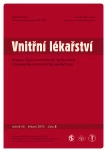Persisting symptoms, diastolic dysfunction and decreased coronary flow reserve after succesful correction of aortic recoarctation
Authors:
M. Šebo 1; T. Zatočil 1; A. Nečasová 1; T. Brychta 1; J. Černý 2; P. Kala 1; J. Špinar 1
Authors‘ workplace:
Interní kardiologická klinika Lékařské fakulty MU a FN Brno, pracoviště Bohunice, přednosta prof. MU Dr. Jindřich Špinar, CSc., FESC, 2Centrum kardiovaskulární a transplantační chirurgie Brno, ředitel doc. MU Dr. Petr Němec, CSc.
1
Published in:
Vnitř Lék 2010; 56(3): 247-250
Category:
Case Reports
Overview
We present a case of a 53‑year - old woman undergoing successful surgical treatment of coarcation restenosis after patch grafting in childhood. Despite the optimal result of the operation, normal left ventricle systolic function and coronary angiogram, majority of symptoms, such as angina and dyspnea, persist 16 months after the intervention. In further investigation, pathological values of left ventricular end‑diastolic pressure (LVEDP = 30 mm Hg) and coronary flow reserve (CFR = 1.3) were confirmed, implicating recoarctation to be the unusual cause of cardiac syndrome X.
Key words:
recoarctation – diastolic dysfunction – coronary flow reserve
Sources
1. Popelová J. Vrozené srdeční vady v dospělosti. Praha: Grada Publishing 2003.
2. Gatzoulis H et al. Adult congenital heart disease – A practical guide. Wiley - Blackwell, 2008.
3. Hučín B. Dětská kardiochirurgie. Praha: Grada Publishing 2001.
4. Reich O, Tax P, Bartáková H et al. Long‑term (up to 20 years) results of percutaneous balloon angioplasty of recurrent aortic coarctation without use of stents. Eur Heart J 2008; 29 : 2042 – 2048.
5. ACC/ AHA 2008 Guidelines for the management of adults with congenital heart disease. J Am Coll Cardiol 2008; 52; e143 – e263.
6. Kala P. Tipy a triky měření koronární průtokové rezervy. Interv Akut Kardiol 2005; 4 : 233 – 235.
7. Hager A, Kanz S, Kaemmerer H et al. Exercise capacity and exercise hypertension after surgical repair of isolated aortic coarctation. Am J Cardiol 2008; 101 : 1777 – 1780.
8. Lam YY, Mullen MJ, Kaya MG et al. Left ventricular long axis dysfunction in adults with “corrected” aortic coarctation is related to an older age at intervention and increased aortic stiffness. Heart 2009; 95 : 733 – 739.
9. Lam YY, Kaya MG, Li W et al. Effect of endovascular stenting of aortic coarctation on biventricular function in adults. Heart 2007; 93 : 1441 – 1447.
10. Marshall AC, Perry SB, Keane JF et al. Early results and medium‑term follow‑up of stent implantation for mild residual or recurrent aortic coarctation. Am Heart J 2000; 139 : 1054 – 1060.
11. Cook SC, Ferketich AK, Raman SV. Myocardial ischemia in asymptomatic adults with repaired aortic coarctation. Int J Cardiol 2009; 133 : 95 – 101.
12. Perloff H et al. Congenital heart disease in adults. Saunders/ Elsevier 2009.
13. Kuroczyński W, Hartert M, Pruefer D et al. Surgical treatment of aortic coarctation in adults: Beneficial effect on arterial hypertension. Cardiol J 2008; 15 : 537 – 542.
Labels
Diabetology Endocrinology Internal medicineArticle was published in
Internal Medicine

2010 Issue 3
Most read in this issue
- Contribution to differential diagnosis of chronic abdominal pain
- Persisting symptoms, diastolic dysfunction and decreased coronary flow reserve after succesful correction of aortic recoarctation
- Treatment of adult acute lymphoblastic leukemia according to GMALL 07/ 2003 study protocol in the Czech Republic – the first experience
- Non-alcoholic steatosis and steatohepatitis – editorial
